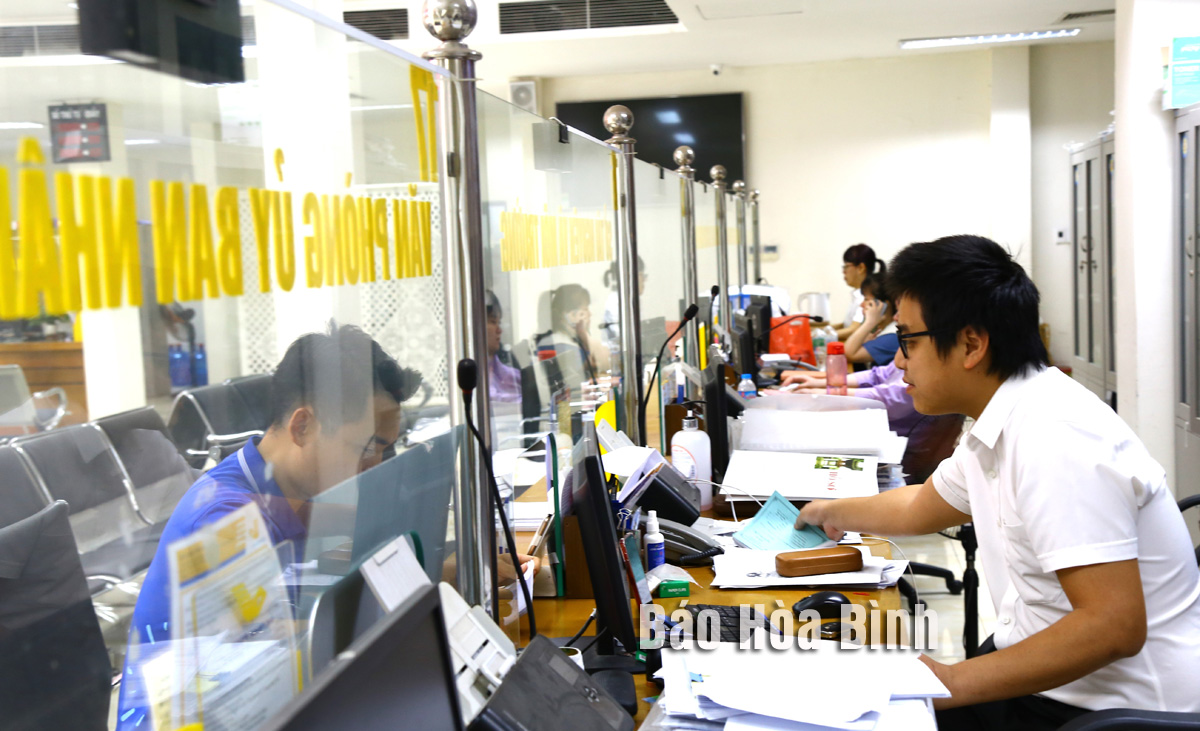
Hoa Binh province’s public administrative service centre has implemented the "people and business-centred administration” model since 2018. It has been equipped with modern equipment, including an automatic ticketing system, surveillance cameras, computers, scanners, and software so that administrative procedures have been settled and results returned in a timely manner.

Staff at the
provincial Public Administrative Service Centre guide organisations and
individuals on how to complete administrative procedures
The centre has set up a support team to assist people who
are not familiar with using computers. They will be assisted in creating
accounts, submitting documents and making online payments.
To encourage people and businesses to use online public
services which can reduce time and save costs, the centre has conducted the
communication work through various channels, such as Hoa Binh Newspaper, Radio
and Television Station, and Zalo app at Hoa Binh province's public service
portal, and distributing leaflets on the benefits of using such services. It
also provides guidance for individuals and businesses through the one-stop shop
division and portal’s hotline at 1022.
From the beginning of the year until August 2, the centre
received and processed 60,902 administrative requests. Most of the requests
were dealt with on time. The percentage of those returned due to insufficient
conditions or finished behind the schedule was low and mainly relating to land
and construction.
Quach Thi Thanh from Quynh Lam ward in Hoa Binh city said
that this is the first time she has come to the centre to apply for a household
verification for her child's job application. She found the centre is
well-equipped and information about administrative procedures are publicised
clearly, adding that she is very satisfied with the attentive guidance provided
by the centre’s staff.
According to Ha Thi Ngoc Trang, the centre’s deputy
director, it has continuously innovated and shifted its mindset from
'administrative management' to 'service administration,' building a
people-friendly administration that aims for the satisfaction of people and
businesses.
The implementation of the "people and business-centred
administration” model has helped build trust and consensus among people and
businesses regarding the leadership of the Party Committee and administration,
contributing to the successful realisation of the province's political tasks.
Hoa Binh province is undergoing a dynamic transformation amid Vietnam’s national digital transition. Building on Poliburo’s Resolution No. 57-NQ/TW on breakthroughs in science, technology, innovation, and national digital transformation, the province has rolled out a wide range of practical action plans. A standout initiative is the "Digital Literacy for All” movement, an effort to ensure that no one is left behind in the digital era.
Hoa Binh province is undergoing a dynamic transformation in the wake of the national digital transformation movement. Building on Resolution No. 57-NQ/TW of the Politburo on breakthroughs in science, technology, innovation, and national digital transformation, the province has implemented a wide range of practical action plans. A standout initiative is the "Digital Literacy for All” movement ambitious effort to ensure that no one is left behind in the digital age.
With a spirit of unity and proactive problem-solving, the Party Committee, the government and the people of Dong Lai Commune (Tan Lac District) have made great strides in implementing the resolutions of the 24th Party Congress of the commune for the 2020 - 2025 term. Focusing on leadership and practical actions, the commune has brought the Party’s resolutions into daily life, creating strong impacts and pushing the local development forward.
Amid the nationwide push for digital transformation, young people in Hoa Binh Province are stepping up as dynamic pioneers, applying technology to enhance Youth Union operations and expand the reach of youth-led initiatives. Through creativity and adaptability, Youth Union organizations at all levels have introduced a series of practical solutions, contributing to modern governance and community development.
In recent years, An Nghia commune, located in Lac Son district, has stepped up administrative reform, focusing on improving the quality and efficiency of its single-window service unit for receiving and processing administrative procedures. These improvements have helped create favourable conditions for local residents and organisations to handle administrative procedures, contributing to the commune’s broader socio-economic development.
The Prime Minister-approved master plan to develop the multi-use value of forests ecosystems through 2030, with a vision to 2050, aims to improve the management and sustainable use of forest resources, create jobs, increase incomes, and improve the living standards of ethnic minorities, people in mountainous and remote areas, forest workers and those living near forests.



